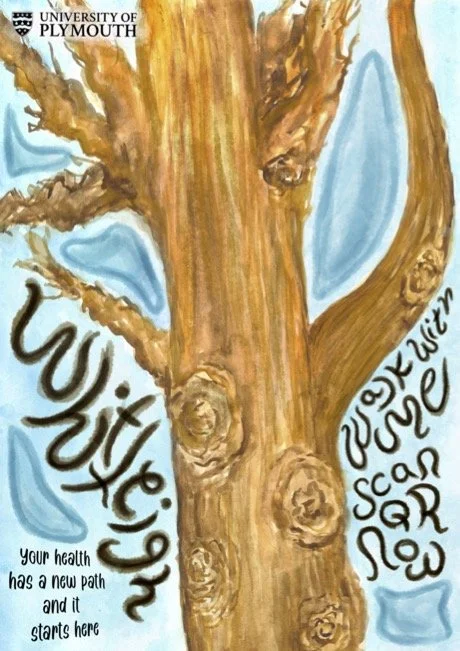
Community-led Design for Digital Inclusion and Wellbeing
As part of my postgraduate design practice, I collaborated on Whitleigh Woods Walk With Me, a community-centred digital intervention addressing digital inequality and wellbeing among older adults in Whitleigh, a socioeconomically challenged suburb in Plymouth. This project emerged from the intersection of inclusive design, forest therapy, and digital health ethics, and was developed in partnership with Whitleigh Community Trust.
Our project tackled a pressing problem: older adults in the UK, especially in underserved communities like Whitleigh, often face barriers to digital engagement, including limited access, skills, and confidence. Drawing on the UK’s Digital Inclusion Action Plan (2025) and literature on “successful ageing” (UNECE, 2021), our app aimed to improve digital confidence while also offering therapeutic engagement with local green space. The app offered five curated walking trails in Whitleigh Wood, each developed to support users’ sensory immersion, mobility needs, and psychosocial preference
My contribution to the project focused on experience design and methodological integration. I helped define the theoretical grounding by incorporating frameworks from green social prescribing (Rigolon et al., 2021; Haywood et al., 2023), forest therapy (Li, 2009; Ikei et al., 2018), and digital ageism studies (Berner et al., 2022; Mannheim & Köttl, 2024). These frameworks informed our understanding of the systemic exclusions older users face, not only in technology but in health access and social inclusion. We aimed not only to design an app but to create a restorative system of care grounded in design ethics, nature-based therapy, and user empowerment.
Our process was firmly grounded in community-led and ecological methodologies. We conducted on-site ecological fieldwork to understand Whitleigh Wood’s physical affordances and constraints, from its mixed canopy structure to problematic muddy terrain. These observations directly informed trail planning. I worked with my team to differentiate each trail typology based on terrain, hydrology, and habitat: The Whitleigh Woodland Loop offered a gentle, fully accessible introduction to the app; the Texture Scavenger Hunt focused on tactile interactions with tree bark; The Whispering Path used audio orientation via natural soundscapes; The Meditation Path was designed for solitary, restorative movement; and The Social Path supported informal social interaction through embedded resting points.
Our team was interdisciplinary, comprising students from experience design, game design, and communication design. I coordinated closely with the technical lead and the community liaison to ensure our interface and trail content reflected real user needs. For instance, we avoided swipe gestures and used single-tap navigation to reduce cognitive and motor load. This insight was shaped by feedback from our community testing sessions, where one participant, Star, noted that swiping was unfamiliar and frustrating. We also addressed emotional usability by incorporating familiar and non-threatening visuals, including hand-painted animal illustrations and a soft green-blue colour palette designed for visual clarity and emotional calm.
Virtual Nature
*
Virtual Nature *
A major innovation of the app was the integration of animal sound interaction. I led the design of this feature as part of our multisensory strategy, ensuring that even users who could not physically explore the trails could experience auditory immersion. Each animal—owl, squirrel, deer, and eagle—was represented through custom watercolour illustrations. Users could tap to hear their sounds, a low-barrier interaction that supported mental presence and nature-connectedness without requiring visual or physical exertion. This feature was especially appreciated by mobility-limited users, who told us that “some people may never walk the full trail, but they can still feel it.”
Additionally, I contributed to the naming and narrative development of each trail, ensuring they reflected therapeutic values and invited emotional engagement without pressure. Trail names like A Gentle Hour in Nature or The Whispering Path were chosen to communicate safety, ease, and openness. This linguistic framing was crucial to reduce perceived intimidation among users unfamiliar with digital tools.





We tested the app through community feedback sessions with Whitleigh residents and local partners. Insights from these sessions revealed key refinements, including increasing font size, clarifying button labels, and offering a tutorial video. While we did not have the time for longitudinal field trials, these informal walkthroughs highlighted the app’s accessibility strengths and revealed opportunities for future development, such as adding voice-interactive features to allow for hands-free operation.
In the final stage of the project, we developed communication materials that extended the app’s visual identity into the public space. I collaborated on the concept for our posters and the narrative integration of site-specific features such as local trees, glades, and “The Wizard Tree,” a fictional but emotionally resonant figure central to our campaign. These posters were printed and displayed at our showcase, reinforcing community recognition and a sense of ownership over the project.
image created by Renee Poulton
Ultimately, Whitleigh Woods Walk With Me is more than a mobile interface, it is a situated, ethical response to overlapping inequities in ageing, digital exclusion, and environmental disengagement. As a designer, I learned how to build bridges between theory and practice, between multisensory design and community narrative, and between digital confidence and nature-based care. This project represents my commitment to discursive design as a tool for the public good and to crafting systems that not only work but also care.





